
CRUISING ON A CAT IN THE BAHAMAS TRIMARANS ON THE WING 2024
FAVORITE SPOTS IN THE BRITISH VIRGIN ISLANDS








CRUISING ON A CAT IN THE BAHAMAS TRIMARANS ON THE WING 2024
FAVORITE SPOTS IN THE BRITISH VIRGIN ISLANDS






DURING THE MULTIHULL REVOLUTION THAT has been taking place over the last two decades, trimarans have enjoyed a similar if smaller growth in popularity.
In this issue, we are happy to bring you a special editorial section on trimarans and I hope you will find the profiles and reviews of interest. We certainly did as we put the feature together.
Trimarans have been around for decades and grew in popularity on the cruising fringe with home-built designs from inventors like Walter Greene. But it was Phil Weld’s victory in the 1980 Observer Singlehanded Transatlantic Race (OSTAR) aboard his Dick Newick-designed tri Moxie that really sparked awareness of the design’s superior sailing qualities. Also, Moxie looked like a handsome seagull on the wing soaring over the waves.
Today, a whole crop of new and equally birdlike trimaran designs are being built around the world and cruising sailors are increasingly likely to own one. A trimaran’s one drawback is its beam, but Ian Ferrier’s development of folding amas, seen on Corsairs, Dragonflys and Rapidos and all slightly different, solves the problem of mooring tris in marinas.
And, the development of NEEL tris, with their huge living spaces, has brought boats to market that combine the sailing qualities of a tri with the interior volume of a catamaran. In my view, trimarans have a special place in the cruising fleet and will always appeal to sailors who love to sail, love to sail fast and love to push the edge of design and technology. Fair winds.
Editor and Publisher
George Day
george@bwsailing.com
Contributing Editors Art Director
Bill Biewenga
Rebecca Childress
John Neal
Sandy Parks sandy@bwsailing.com
Advertising Sales & Marketing Consultant
Tom Casey tomcat911@comcast.net
MT-Multihulls Today is published by Blue Water Sailing LLC in February, May, August and November. Copyrighted 2024. All rights reserved.
Reprinting, photocopying and excerpting passages is forbidden except by permission of the publisher.
Blue Water Sailing ISSN: 1091-1979


www.leopardcatamarans.com I info@leopardcatamarans.com
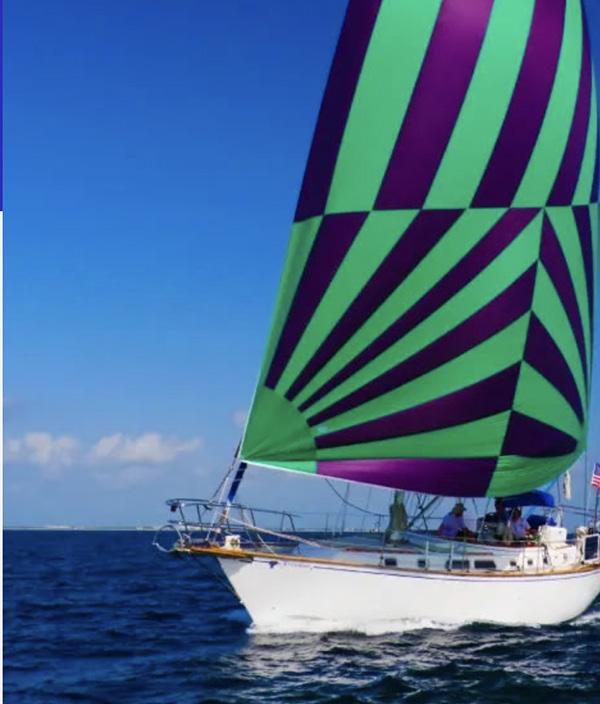
BASED IN STUART, FLORIDA, MACK SAILS stands alone in the community of sailmakers in the U.S. A family run business founded by Brad Mack in 1967 now spans two generations, the company is run today by Brad’s son Travis Blain who took a regional sailmaker and transformed it into a national and even international sail making and rigging business.
Travis’s brother Colin Mack was a partner in the loft into 2019. Colin now runs a marine services company specializing in all types of yacht repair and service. And, while Mack Sails can and does build racing sails, their loft has truly found a home as a sailmaker of choice for the cruising community.
Unlike the largest sailmakers, all of Mack’s sails are built at the loft in Stuart and all are hand-made by local sailmakers and finishers. Your sails aren’t coming from Sri Lanka or other Third World countries.
By keeping their sail making local, Travis can ensure that each sail is built
to the buyer’s exact measurements and specifications and that each sail that goes out the door meets their high standards.
Yet, their clientele is all over the world due in no small part because they buy new sails before heading off for extended cruises that take them to the Bahamas and Caribbean, across the Atlantic and south to Panama and beyond.
I live in Rhode Island, but I had Travis and Colin build a mainsail and jib for my Jeanneau 45.2 and the whole process went as smoothly and seamlessly as if their loft was around the corner. Not only did the sails fit exactly as they should, the fit and finish more than met our expectations.
We have an in-mast roller furling main so Travis specified vertical battens for the mainsail that didn’t overlap as the sail rolls into the mast. That reduces the thickness of the rolled sail and lessens any chance of snagging in the mast opening. It also reduces chafe. After a couple of years and in consultation with Travis, we decided to experiment and add a fourth short vertical batten at the top of the sail to give the leech a bit more support. Travis did this incredibly quickly and the result was just what we hoped it would be. We’ve put over 10,000 miles on that sail and know it has another 10,000 still in it.
They built a miter-cut genoa for us, too,

Congratulations Norhi!
Balance Catamarans’ 526 skippered by its owner crossed the finish line first in this grueling race in a lapsed time of 18 days, 20 hours, 48 minutes and 16 seconds! A fast race with a great team of sailors. Repeat after me: “Balance Catamarans are fast. Balance Catamarans are gracious.” Mantra.


that fit the ProFurl roller furling headstay perfectly and the luff bolt rope slid into the luff groove tightly but smoothly. This sail also has been all those miles, too, and has been through three full gales at sea. Sun and strong winds will take a toll on a Dacron roller furling headsail after all those miles and when flown partially rolled up, but the genoa still is holding its shape nicely and shows very little wear and tear.
Quality Sail Cloth Makes the Difference Mack primarily uses sail cloth from Challenge Sailcloth and Contender Sailcloth which each offer several grades of woven polyester fabrics (Dacron) of differing quality and price. The less expensive versions are often what the largest sail making companies use for their “cruising sails” since laymen sailors find it hard to tell the difference. Yet, cruisers who have blue-water sailing in their plans, need something better. That’s why Mack only uses Challenge and Contender’s premium brands, High and Low Aspect (Contender) and Marblehead High and Low aspect (Challenge) which are also woven in the USA.
“The yarns for these best cloths are very tightly woven on specialized looms with


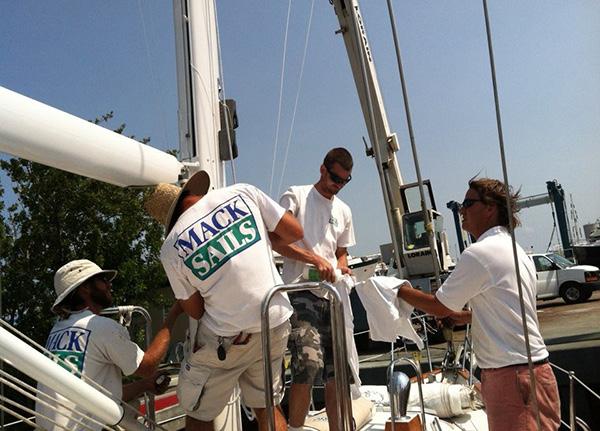
emphasis on high crimp (slow, strong looms that super pack the heavier fill yarns against the warp yarns in the weaving process). High Aspect Dacron has heavier fill yarns that locate in the load direction of most mainsails and skinny jibs. The Low Aspect style is more balanced (fill and warp yarns of a more even denier) and is the absolute best for properly designed Dacron headsails and is particularly well suited to Mack Sails’ miter-cut roller reefing genoa.”
Sails built with less expensive and more loosely woven fabrics tend to lose their shape and start to break down much faster than the more tightly woven fabrics. So, for buyers who want longevity and sail shape retention, the slightly higher cost of High Aspect and Marblehead cloth is more than worth it.
Mack also offers Fast Radial Sails built from laminated cloth made up of one to two
mils of Mylar with Carbon and Technora fibers for shape holding. They can also have an outer layer of Dacron Taffeta on each side for added durability. These more expensive sails hold their shape very well and are favored by club racers or performance oriented offshore racers. But the sails do have a shorter lifespan than woven Dacron sails built with the best quality cloth.
People have been making sails for three thousand years and there is no question that along the way we have learned a thing or two about what works and what doesn’t. And, it is fair to say that cruising sailors as a group tend to be both adventurous and conservative; adventurous because they sail over the horizon and conservative because they need to trust their gear to work when they need it to work, especially their sails.
Our rigging department installed a new Schaefer Gamma Boom on this Manta 42 that makes regular runs from the east coast of Florida to the Bahamas. We then built a new jib for the existing camber boom and new full batten mainsail for the rollerfurling boom. Our extensive experience with offshore catamarans and with furling booms provided our customer with a great integrated system.

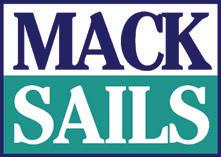
Racers push the envelope in search of ever better performance and cruisers generally trail behind them in adopting new technologies – fabrics and build techniques. At Mack, sails are designed with modern technologies and cut using modern machines. Yet, each cruising sail, has a lot of hand work in it.
On sails with cloth heavier than six ounces, all seams are sewn with 2 rows of a ½” wide triple stich with heavy duty, UV resistant threads. The corner rings and reef cringles are all stainless steel and hydraulically pressed into place. Headboards are all aluminum panels that are fixed into place with aircraft rivets. Leeches, clews and tacks are robustly layered and batten pockets all have four layers of cloth. Mast slides are hand sewn into place as are leather-bound chafe
• Multi Awning
• Stretched between cap shrouds, mast & headstay
• Hoisted with spinnaker halyard
• Top notch 9 oz. material
• Sewn with goretex thread
• 8-Year warranty
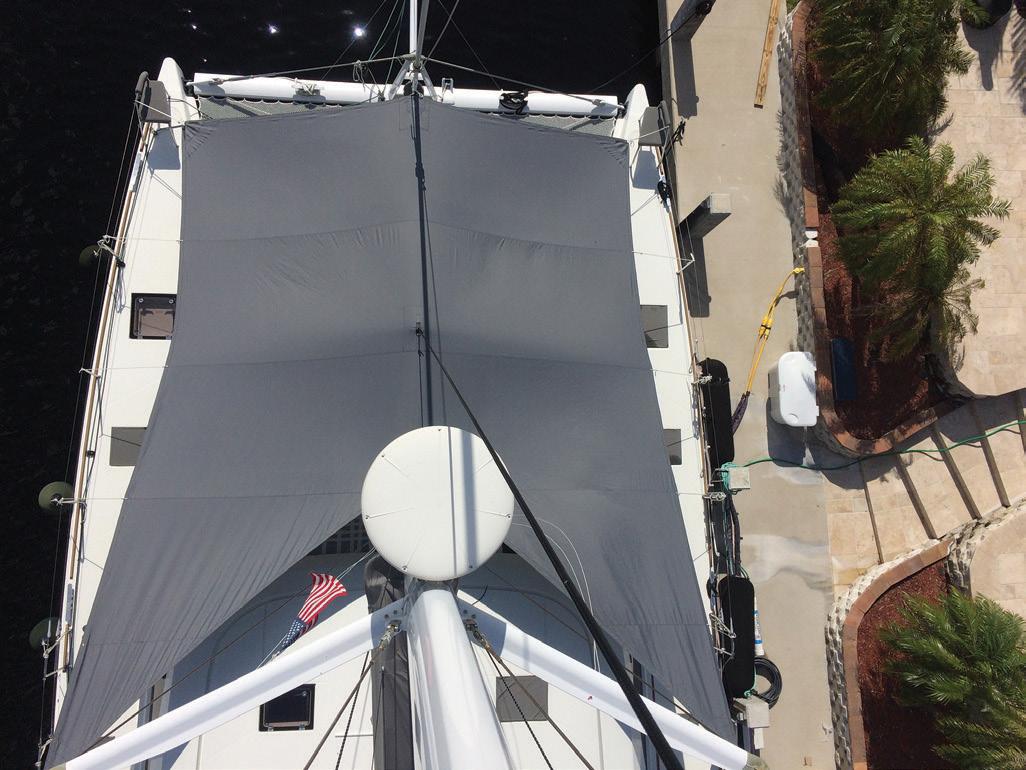
protectors on the clews of both mains and genoas and all our sun covers and Mack Packs are sewn with Tenara thread. So, each cruising sail combines the benefits of modern computer design and modern sailmaking equipment with the traditional sailmaking skills and handwork that offshore sailors trust.
As Mack Sails grew, adding a rigging shop that could serve a wider range of client needs just made sense. So, now the Mack rigging department can handle all rigging upgrades, repairs and modifications. If you need a new mast, they represent Forespar, Selden, Z-Spar and Sparcraft. For roller furling, they cover all the major brands including ProFurl, Harken, Schaefer and others. In recent years, Mack has become known

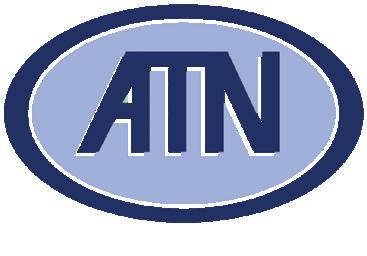
as a go-to shop on the East Coast to retrofit an in-boom roller furling mainsail system. These are particularly useful and popular on larger catamarans, especially with flying bridges because the main boom is so high off the deck and hard to get to when reefing or furling the sail. In-boom systems from Forespar and Schaefer, make mainsail handling easier and safer. And, the riggers at Mack can help train you when learning to use these somewhat complicated reefing booms.
As I mentioned above, Travis and Colin built new sails for my boat and the whole experience was on a one-on-one basis with the guys who own the company. When your name is on every sail you

built, you know where the buck stops if a customer has a question or an issue that needs resolving.

I often see Travis at boat shows and there is always a crowd around the Mack booth. They have been in business for a long time—50 years or more—and, as they say, you can judge a man or a company by the quality of their friends. Mack Sails has thousands of old friends who are repeat customers. It is no mystery why.
Check out the Mack Sails website here.
Discover the full range of Dragonfly Trimarans and see for yourself why the Dragonfly 40 Ultimate was awarded 2024 Boat of the Year
call 404.307.9121 or email Info@DragonflyTrimarans.us
www.windcraftmultihulls.com
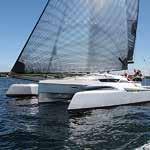
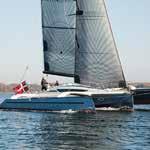
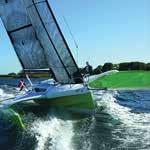

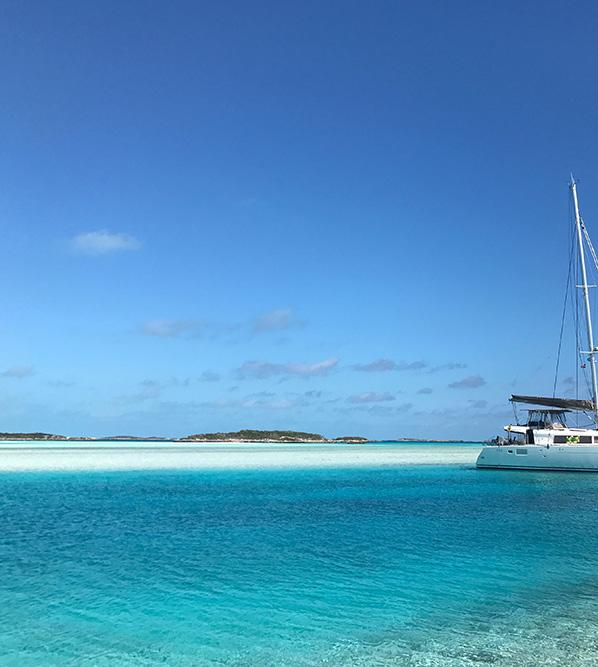

The crew of Sacre Bleu, a Lagoon catamaran, explore this magical cruising ground
by Jim ToomyAFTER A 30-HOUR CROSSING, WE DROPPED the hook off Matthew Town, Great Inagua Island, at midday. Sacre Bleu was the only boat in sight. Just the morning before, we were anchored in the muddy Bay of Luperon, Dominican Republic, surrounded by mangroves, in a veritable floating village of boats covered with jury-rigged awnings, dish antennas and potted plants. Now, here we were in The Bahamas, gazing through water clear as air, at coral reefs, fields of seagrass and the sea creatures wandering through it all: a school of yellowtail snapper here, a barracuda there, a sting ray just below. Bahamian water is like no other on the planet. It’s a clear window into what is usually a mysterious and hidden world.
We had the entire month of May to explore this nation of 700 islands. Continuing our slow northward trek from Great Inagua, we sailed to Long Island over water that was dark blue, almost black. As we rounded the north end of Long Island and entered Calabash Bay, the water abruptly turned the color of a swimming pool. We had just passed over an underwater cliff that rose from a depth of 12,000 feet up to the Great Bahama Bank, a sun-dappled shallow plain of white sand as far as the eye can see. Only from the deck of a small boat can one appreciate just how shallow and expansive this stretch of clear water is. As we glided over miles and miles of tabletop-flat sea bottom, dappled with geometric patterns of sparkling sunlight, we saw sharks, rays, barracudas, and other big, dark shapes darting away in a flash, startled by our shadow.
The seafloor in The Bahamas is like a desert,

with sands continuously shifting, building up shoals and carving out channels. Here, nautical charts are of little use. The safest way to navigate is by positioning a crewmember on the bow to assess water depth based on color. Water that is 15 to 20 feet deep appears as medium aquamarine blue. Water that is the palest of light blue is still five or six feet deep, just enough to float Sacre Bleu. Dark patches indicate coral reefs. Since red and yellow light is quickly absorbed by water, deeper reefs appear black, while shallower, more dangerous reefs show their true browns, reds, and yellows. Like a token on a giant game board, we moved about, our path determined by colors.
We were eager to see the Exumas, a group of islands that includes the Exuma
stingray.
Cays Land and Sea Park, a marine reserve with even more pristine anchorages, dive sites and hiking trails on shore. We followed the island chain north to Little Farmer’s Cay, and for the entire 45-mile trip, we drove over water that was six feet deep, leaving a slim 18-inch clearance between our keel and the sand. As we sailed along at eight knots, I could not stop worrying about the anomaly—a rock or a hill—that might rise more than 18 inches from the seafloor, but all of that worrying was for naught. The bottom was flat as a parking lot.
Near sundown, with several more miles to go, we encountered violent squalls. With no sunlight, it was impossible to
gauge the water depth ahead of us, so we stopped dead and drifted, anxiously assessing our next move. The squalls continued, with strong wind and driving rain, and night began to fall, forcing us to act. We consulted three different charts: the ship’s electronic system, an iPad application, and a paper chart. We inched our way forward, finally found water suitable for anchoring and stopped for the night. The squalls passed, a starry night opened up overhead, and a warm breeze blew gently over the deck. It was another day on the boat that touched all the emotions, from bliss to terror and back again.
Certain cruising communities in The Bahamas could be described as permanent in location but transient in
membership. For example, off Stocking Island near George Town, where we sat on anchor for a week, a communitydesignated boat in the anchorage broadcasts a VHF radio show twice a day that includes the weather report, a reading of items for sale by other boaters, activities and happy hour gatherings. When this boat departs, another amateur DJ takes over. On Big Major Cay, we stumbled on a sailing community that gathers on an inconspicuous stretch of beach permanently set up as an unofficial clubhouse, with tables, hammocks, a tiki bar and a fire pit.
Big Major Cay has become a global tourist attraction in recent years. Here, and only here, visitors can witness the unique juxtaposition of sparkling aquamarine
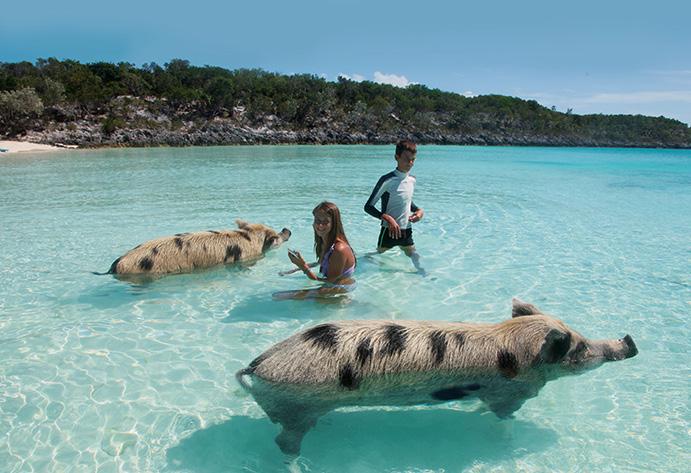 Pigs in paradise: Big Major Cay, Bahamas.
Pigs in paradise: Big Major Cay, Bahamas.


water and feral hogs. These swine are not shy. When visitors land on the island, to get a jump on their rivals for food, the animals swim out to meet the new arrivals. As pigs paddle over the surface of the clear water, harmless nurse sharks glide below, bringing two creatures together that should never cross paths in nature. The larger pigs bully their way into the line-up, pushing the piglets aside like bowling pins as they throw their snouts into an approaching dinghy.
Passing sealife in one form or another was a regular part of any swim. Madeleine and William surrounded by Caribbean reef sharks off New Providence Island.
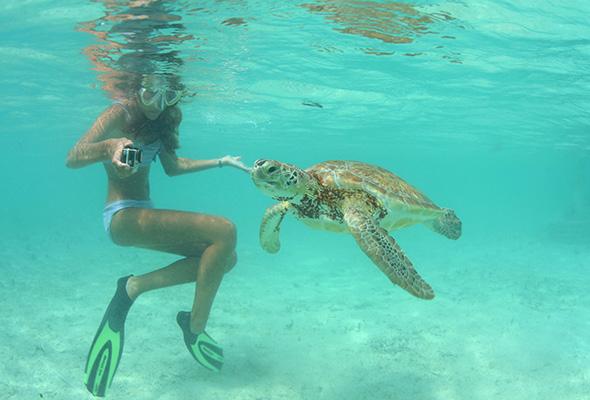
Just a little farther north at Warderick Wells, inside the Land and Sea Park, another sailing community is building an art installation of sorts. At the top of Boo Boo Hill, passing sailors add a piece of driftwood with their vessel’s name to an ever-growing sculpture. Madeleine made a day’s work out of creating our contribution: a scrap of driftwood with “Sacre Bleu 2017” painted on it. Conscious that we were part of a greater collaborative work, we tried a dozen different places before settling on just the right location. In the end, no spot seemed ideal, and we had to force ourselves to just pick a place. That is the way with most art—it is not finished, it is abandoned.

Just when we thought The Bahamas could not offer any more exquisite combinations of clear water and white sand, we stumbled onto Shroud Cay, our last stop in the magical Exuma Land and Sea Park. While all the islands of the Exuma Cays might look the same on a chart, each is unique in some surprising way. About three miles end to end, Shroud Cay is pierced coast to coast by clear, sandybottomed aquamarine rivers teeming
with ocean wildlife. For tropical fish, sea turtles, rays, and sea birds, these ribbons of saltwater are merely extensions of their ocean homes. We explored the island’s interior in the dinghy, at one point getting lost in the confusion of tributaries.
The Atlantis, Paradise Island Resort in Nassau could not be more different from the Exumas, but with two children on board, we couldn’t just sail by it. Madeleine and William had exhibited an adult-like patience and curiosity over these many months of travel, and it was time to cut them loose at this world-

famous resort/waterpark so they could be children for a day. Both kids were in their bathing suits before we had finished tying up to the dock. “The Power Tower is the place to start,” William declared, as he surveyed a brochure of the waterpark with furrowed brow, like a general going into battle.
For real thrills, on our last day in Nassau, we went on a shark dive. In my comic strip, Sherman’s Lagoon, Sherman the shark defies the public image of these animals being mean and aggressive; Sherman is lazy and unambitious. I wanted to show the kids that sharks, with a few notable exceptions, are not like their public image, they’re more like Sherman. A dive operation called Stuart Cove’s offers excursions that bring people and sharks together in one place. We put on scuba gear, went offshore in a dive boat and
dropped to a depth of 40 feet, where 20 to 30 large Caribbean reef sharks swam in circles around us. The kids were frightened at first, but they soon realized that the sharks were less interested in them than in the fish the divers were handing out. The sharks swam by, sometimes within inches, giving us a chance to admire these wild predators up close.
The days were passing quickly, and our time in The Bahamas was coming to an end. The next morning, we continued our northward trek, sailing 55 miles in near-perfect conditions to the Berry Islands. Sacre Bleu lifted out of the water and kicked up a giant wake behind her twin hulls as the westerly breeze filled her sails. It

was a fitting last day of sailing in foreign waters for us. Early the next morning, we would set a course for Charleston, South Carolina, and soon after that, home to Annapolis. A several-hundred-mile leg through open ocean had become routine for us. Our watch system now included the kids, and everyone knew their roles and responsibilities. As a family and a crew, we now felt like we could go anywhere.
Jim Toomy’s book Family Afloat is available on Amazon Prime More about the voyage here
Jim Toomey is an internationally published humor writer and syndicated cartoonist best known as the creator of the popular comic strip Sherman’s Lagoon, published daily in over 150 newspapers, including the Washington Post , the San Francisco Chronicle and the Chicago Tribune . Valerie Toomey moved to the U.S. from her native France 25 years ago. Since then, she has worked in international shipping, run a children’s boutique, and for the past 10 years worked in the boating industry, currently as a yacht broker for Atlantic Cruising Yachts.


A repeat charterer reflects on his favorite spots in these well-known islesby
IT’S BEEN MORE THAN TWO DECADES SINCE I last saw the sun steal across the sapphire sky of the glorious British Virgin Islands. I gazed up at the fiery sphere from aboard my chartered sailboat securely anchored in Scrub Island Marina, and reflected on the enduring beauty here that somehow never fades.
Sailing these virgin waters several times

The Baths are still among the most popular places to explore
over some 40 years of chartering is always a special event for a variety of reasons— the least of which is the magnificent sailing experiences these waters afford boaters. While I’m not an actual sailor in the true sense of the word, I fell in love with sailing at the beginning of the 1980s, and stayed connected to the pastime by chartering a yacht at least one a year with a group of friends or family.
The BVIs were the first place I boarded a sailboat and my passionate love for these islands was born. Returning to the BVIs over the years has always held a special meaning and each time, I’m able to make new memories to add to those already precious to me. What’s particularly notable during each visit here is that while things change in the islands, much remains the same, and it’s really comforting to be in
such warm and welcoming surroundings. On this special journey, I was joined by my wife Dene, my daughter Robin and her husband Sean, in what would be the 20th anniversary of a sailing trip we took to the BVIs in mid-summer of 2001. I was curious to know if famed places like The Baths, The Indians, Foxy’s Bar and other well-known island landmarks were still a significant part of the lure of the BVIs, as well as anything new that had been added since my last visit.
Two things that were obviously prized additions to the BVIs were Scrub Island Resort, where we would spend a few days before boarding our chartered yacht, and Dream Caribbean Blue, a vibrant new charter company founded by Gregg and Chrissy Clum, a husband and wife team who came to the islands on vacation,

became infatuated with all they had to offer and decided it was the ideal location for their luxury yacht charter business.
Dream Caribbean Blue features 18 Balibuilt catamarans in its luxury fleet, with six being in the 55-foot class and others ranging in size from 46-58 feet. All are fully crewed with experienced captains and
The Indians are one of the best places to snorkel or dive, below, Marina Cay is the ideal place to stop for lunch or drinks.
cooks and are meticulously maintained. Our yacht was a 55- foot jewel named Mystic and crewed by Rob Bentley and his wife Belinda—or “B” as she liked to be called. Both are South Africans.
For example, at The Baths, The Top of the Baths features an open terrace with scenic views where you can sample Caribbean favorites like simple Jonny Cakes or conch fritters and other seafood delicacies. CocoMaya on Virgin Gorda specializes in tasty streetfood dishes with exotic flavors tossed in. The menu includes shrimp lettuce wraps, tempura shrimp and the notable CocoMaya house ribs. You get the idea. The BVIs cater to sailors and charter guests in every way possible.
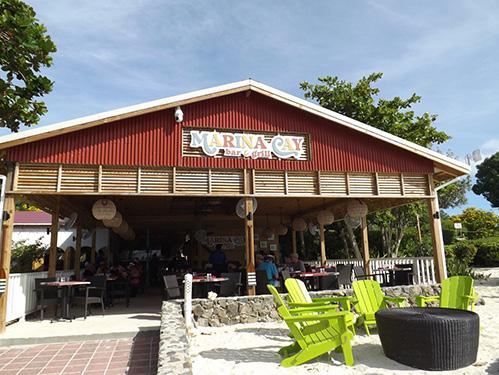
If you’re aboard your own vessel, Scrub Island resort’s marina is the perfect place to put in for the night or for a few days and enjoy the amenities while taking a brief respite from cruising the surrounding waters. Marina guests have full access to all Scrub Island has to offer regardless of whether boaters book a room. We took the opportunity to pair our cruise with a three-day stay at the resort. I looked at it as the anchor portion of our vacation. But when we raised anchor, the BVIs gave
Foxy’s on Jost Van Dyke is still a great place to party.
us the same exciting experiences that it’s been heralded for and that charterers or independent sailors shouldn’t miss.
via a ferry is a spit of land that houses Marina Cay Bar & Grill with a dock to tie up to and where you can come ashore to enjoy some music, a soft sand beach

It’s been more than two decades since I last saw the sun steal across the sapphire sky of the glorious British Virgin Islands. I gazed up at the fiery sphere from aboard my chartered sailboat securely anchored in Scrub Island Marina, and reflected on the enduring beauty here that somehow never fades.
Just around the corner from the resort
and casual, deliciously prepared fresh seafood or juicy hamburgers day and night. The happy hours here combined with a host of weekly events will definitely help your charter or resort visit become more memorable.
Manmade treasures include legendary Foxy’s and Soggy Dollar bar on the island of Jost Van Dyke, Saba Rock Resort in the

North Sound—a haven for yachties and charterers, kiteboarders and divers for more than 50 years—and The Bitter End resort, which has been rebuilt after suffering significant damage during Hurricane Irma. When you’re island hopping, mark these places on your sailing to-do list. There are so many other places to moor, but it would take more than one charter to do them all. Mystic has five cabins, five heads and a maximum capacity of eight guests. It also has all the toys for a charter vacation: outsized dingy, scuba and snorkeling gear, including motorized sea scooters, 10-foot floating dock, zoned sound system, salon TV and branded giveaways such as customized drinking mugs. Dream Caribbean Blue’s marina is at Scrub Island Resort, an all-encompassing 230-acre private island getaway whose name belies its stunning attributes.
On this special journey, I was joined by my wife Dene, my daughter Robin and her husband Sean, in what would be the 20th anniversary of a sailing trip we took to the BVIs in mid-summer of 2001. I was curious to know if famed places like The Baths, The Indians, Foxy’s Bar and other well-known island landmarks were still a significant part of the allure of the BVIs,
as well as anything new that had been added since my last visit.
Sailing these virgin waters several times over some 40 years of chartering is always a special event for a variety of reasons— the least of which is the magnificent sailing experiences these waters afford boaters. While I’m not an actual sailor in the true sense of the word, I fell in love with sailing at the beginning of the 1980s, and stayed connected to the pastime by chartering a yacht at least once a year with a group of friends or family.
Situated on the east end of Tortola, the resort is tucked into a jagged cliff overlooking the tantalizing blue waters of the Caribbean. Its ignominious name was derived from the fact that in the early days of seafaring, boats would be hauled ashore and their hulls cleaned with the

multitude of rocks embedded along its rugged coastline. When I anchored there in 2001, there was no marina or any other facilities, only Donovan’s Reef restaurant, a small eatery surviving on locals that popped in or from sailors and charterers that found it mainly through word of mouth since nothing else on Scrub Island deemed it worthy of going ashore.
The BVIs were the first place I boarded a sailboat and my love for these islands was born. Returning to the BVIs over the years has always held a special meaning and each time I been able to make new memories to add to those already precious to me. What’s particularly notable during each visit here is that while things change in the islands much remains the same, and it’s really comforting to be in such warm and welcoming surroundings.
The sites we visited on those earlier
occasions were still alluring. Targeted must-sees will always be The Baths, whose gargantuan boulders on the coastline of Virgin Gorda leave visitors awe-struck and wide-eyed. It is still possible to maneuver inside the rock walls via small paths, often aided by rope ladders and wooden stairs that didn’t exist when I first came upon the rock formations in 1980. Other things have evolved at The Baths over the years, such as beach souvenir shops and small food stands, visits from cruise ship passengers and a host of beachgoers rather than a handful searching for a unique place to spread a blanket then wade in the water for some snorkeling.
There are plenty of other spots to visit among the collection of 60 lush islands and it takes only a little research to find ones that will fit into your sailing itinerary. Set your compass in their direction and set sail!
 Scrub Island Resort can only be reached by boat.
Scrub Island Resort can only be reached by boat.

I HAD THE GOOD FORTUNE TO SAIL WITH Rick and Julie Palm aboard their wonderful Outremer 51, Archer, from Hampton, VA to the BVI in the Salty Dawg Fall Rally. The boat was nothing short of awesome.
As we emerged from the mouth of the Chesapeake Bay right after starting, we had a northeast breeze blowing about 15 knots over our port quarter. With working sail set, Archer surged along at between 14 and 16 knots, occasionally actually sailing faster than the wind.
We made it to the BVI in record time and
The Outremer 52 combines the best of two great predecessors, the 51 and 55
had one of those offshore passages that stir you to come back for more blue-water sailing.
The 51 proved to be a very successful design for Outremer, the French builder based in La Grande Motte on the Mediterranean, known for performance cruising cats, most with daggerboards.
After the 51, the new 50-footer in their line was the 55 that incorporated many design features and details that were considered improvements and refinements from the earlier design. The 55 was lighter, roomier, more comfortable and faster.

So, when Outremer set out to design a model that could replace the 51, they took a lot of what they had learned in the 55 and applied it to the new smaller cat. The result is a kind of hybrid of the 55 and the 51, yet it is a completely new boat.
The naval architecture for the 52 was done by the
famous firm VPLP while a lot of the aesthetics and refined details are the contribution of the noted French designer Patrick Le Quement.
Note the aft raked bows and the neatly rounded shapes of the sterns. These say “Outremer” and will make the brand recognizable from across the bay. Similarly, the flat top of the cabin and cockpit hard top are one visual line that sits well above the slightly reverse curve of the sheer line.

L-shaped dinette will seat six. Across from it, the galley provides a ton of working area.
Noticeably different from the 51, the windows in the 52 and the hull glazing are much larger and provide a truly enhanced visual experience for those inside the boat and those standing watches in inclement conditions.
The cockpit and the saloon have been made more or less one space separated by sliding doors that disappear when open. The helm has a double seat, like the 55, and has an articulated wheel that can fold down sideways into the cockpit so you can drive under the protection of the cabin and hardtop while keeping watch through the huge saloon windows forward. (We saw this innovation first aboard a Balance cat but it is now being adopted by several builders.)
With the saloon doors open, the galley counter becomes a buffet for those eating at the lovely, varnished teak cockpit table. On the 51, we spent a lot of time at the table while on passage and later in harbor.
The 52’s saloon is full of light and has opening windows forward for a free flow of breeze in warm conditions. The
A nav station is built in at the forward end of the saloon and I can certainly imagine spending night watches here with the instruments and red cabin lights dimmed and the off watch sleeping peacefully in the dinette.
The 52 has four double cabins in the hulls, which share a head between them. But, the builder knows we’re not all in need of four cabins so they have designated the port forward cabin as My Free Space. This can have bunk beds, a workshop, a large storage and closet area or a finished home office.
My positive experience sailing the 51 1,400 miles offshore certainly colors my impression of the 52. Plus, I have been in the Outremer factory and seen in person the quality of construction and the attention to detail that makes the brand a leader in performance and liveaboard comfort.
I’d go to sea on the 52 any day of the week and would love to cruise it far and wide.
Learn more here.
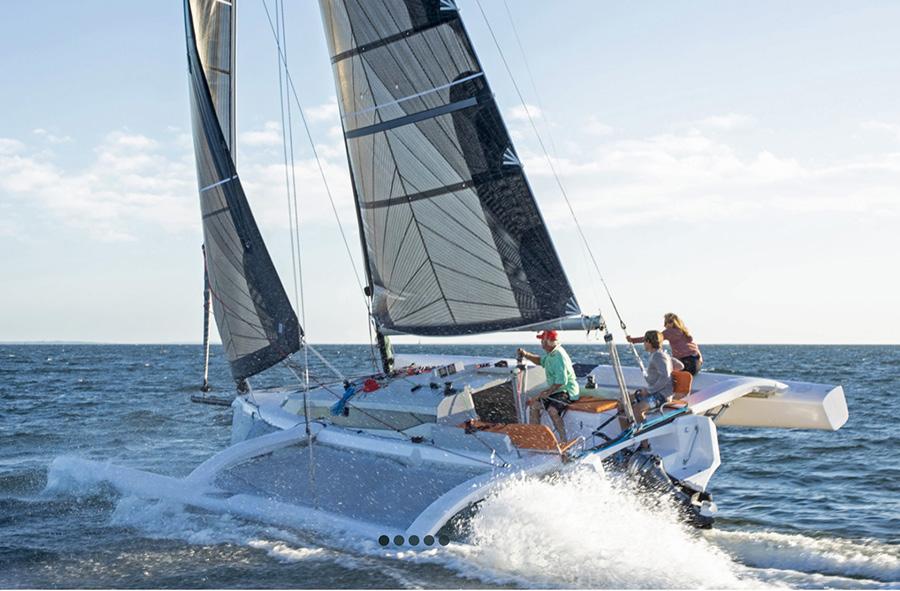
CORSAIR, WHICH IS AN AUSTRALIAN owned company that builds its tris in Vietnam, has long been a leader in the folding-ama trimaran category. Originally conceived by New Zealander Ian Farrier, he developed a simple, robust way to have the amas fold in against the center hull kind of like the wings of a bird.
When folded the boats can be put on a trailer and towed legally over most roads, which expands your cruising grounds enormously. And, it reduces square footage when storing the boat in the off season
Corsair builds four models today. The smallest is the Pulse 600 which is a simple fast day-sailer that is hugely fun to sail
and a great platform for a small family. And, if you get several together, you’re bound to go racing.
The 760 at 24 feet is the descendent of the original 24 that has been sold in the many hundreds around the world. The new 24-footer incorporates all the builder has learned about hull and ama shape, rig size and sail configuration, and about how to create a weekend cruiser for a family of four inside 24 feet. The 760 is a great starter tri.
The 880 fills the slot in the line that was long held by the F-27 and then the F-28. These boats, again, are sailing all over the world and have proven to be fast, fun and great family cruisers. The new
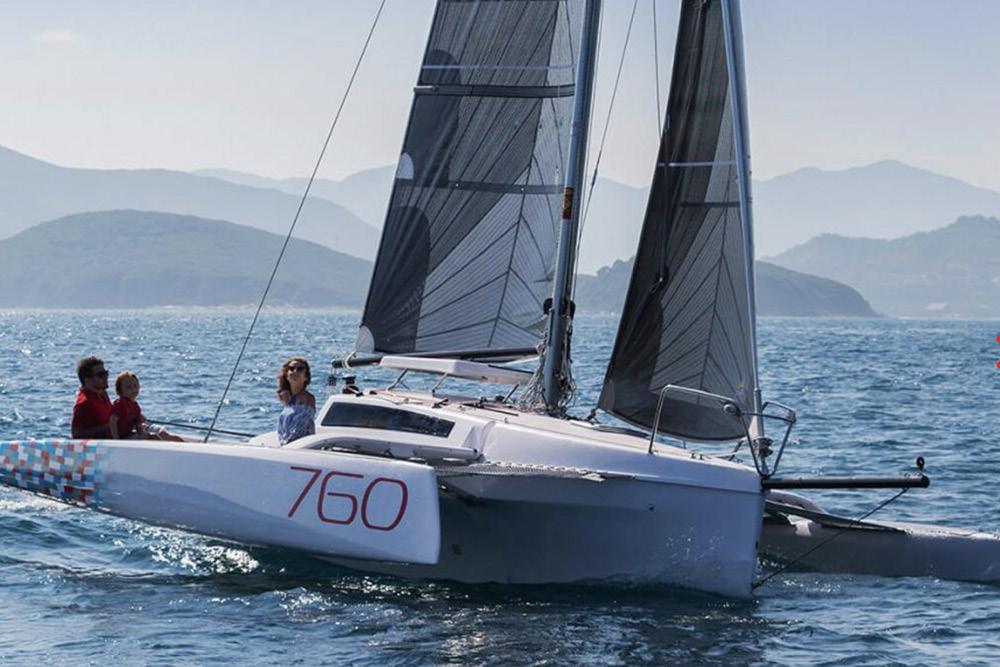
model, like the 760, benefits from years of development and innovation. The amas have new hydro-dynamic shapes, the hulls have more distinct chines and the rigs are taller and fitted with powerful fat-head mainsails. Below you have accommodation for up to six.
The 970 is a direct descendent of the F-31 that became the Corsair 31, both of which are boats that many a cruising family considered to be their ultimate summer cruising boat. Plus, the design has done well on race courses. The 970 is a handsome, weatherly tri that you could take offshore for longer
coastal runs. It would be a great Bahamas cruiser.
Corsair trimarans do not push yacht styling but keep their boats simple, efficient and set up for the pure joy of sailing fast.
Read more.


I AM LUCKY ENOUGH TO HAVE BEEN to the Dragonfly factory and met the company’s owner, Jens Quorning, and the team that builds these lovely cruising trimarans. And, Jens and I have been sailing together a few times as we tested his new boats, the last being soon after the introduction of the Dragonfly 40, the flagship.
The company was founded by Jens’ father and uncle in 1967. Today they still build in the original factory that the brothers built themselves specifically to build trimarans in Northern Europe, something no one had tried before. Their efforts bore fruit. Now 57 years later, Jens
and his son have a team of 50 who build four different models all of which are evolutions from tris from earlier years.
All Dragonflys have folding amas that collapse back against hull and stay in the water providing stability even when folded. This innovation means the boats can fit into slips that were designed for monohulls, which is common throughout Europe.
The 25 is the smallest in the fleet but in some ways it may be the mightiest. It comes in two versions, Touring and Sport. The touring version has weekend accommodations for a family of four and
a standard rig. The Sport version has a taller rig and can be a dominant beast on the race course. Jens and his brother Eric have won major offshore events in the 25.
The 28 when first launched in an earlier design version was truly a game changer for the company. It sold so well that they had a hard time filling orders at first. Since it was big enough to actually spend weeks cruising with a family, –Europeans get a lot of vacation time, remember— and was fast enough to broaden cruising horizons, it changed the attitudes of many experienced monohull sailors. It was revolutionary. The new 28 is a refined version with more modern hulls and amas and a more efficient rig.
The 32 is a proper couples cruising boat that you could sail from Denmark to the Med or across the Atlantic to the Caribbean if you wanted. Roomy, comfortable, endowed with plenty of storage and a large commodious cockpit, the 32 was the ultimate Dragonfly for many sailors. And, it has an inboard engine.



But, the world, and Americans in particular, were looking for a more ultimate Dragonfly so Jens and the company spent years developing the new 40, now the brand’s flagship. The 40 does it all. It is lickitysplit quick but very easy to handle for a couple. It folds so it fits into a slip. It has a roomy main cabin plus berths for six. It has enough storage space for extended living aboard. And, you are
so well protected in the cockpit that you never feel exposed to the elements even in bouncy conditions. It’s simply a wonderful boat.
Read more.

CONCEIVED BY A VETERAN TRIMARAN racer in Denmark to be the fastest cruising tri on the planet, the Marlin 33 has proven to be just that with numerous first-to-finish awards in events throughout Scandinavia and Northern Europe.
Built with ultra-high-tech coring and composite, the boats weigh only 3,300 pounds in sail-ready condition, which includes all sails, safety equipment,
electronics and personal gear. If you are an all-out racer, the 33 can be configured to weigh under 3,000 pounds.
One of the interesting design features lies in the buoyancy of the amas. They have been given enough volume to support flying both the windward ama and the main hull above the waves in the right conditions. This is a most unusual and fast capability usually seen only in MOD 70s and other ultimate racers.
The builders aim to make the 33 energy self-sufficient with 450 watts of solar panels and a battery bank that drives the Toqeedo electric motor for short distances.
The accommodations are pleasant and attractive with the use of black carbon laminate on surfaces that looks modern. The saloon table the builder says, will seat eight. And there are berths for six.
If you’ve got the need for speed and want the Ferrari of trimarans, check out the Marlin 33.
Read more.



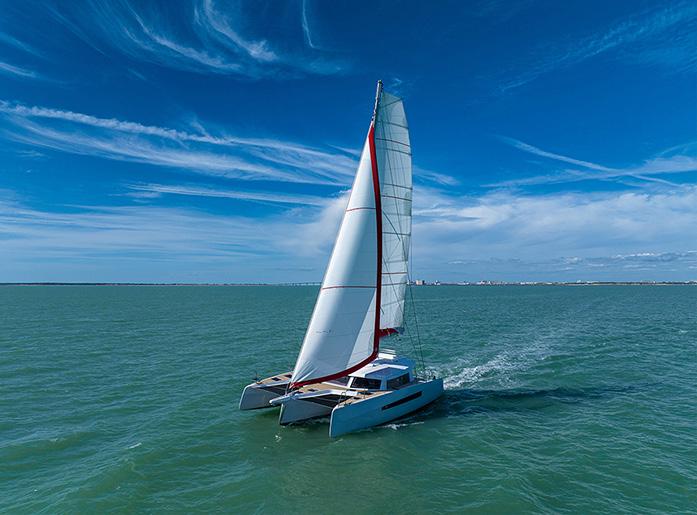
EVERY NOW AND THEN, NO MATTER WHAT field or market you are in, someone comes up with a concept that disrupts everything you thought you knew. In the multihull yacht realm, that is exactly what Eric and Barbara Bruneel did when they launched the NEEL trimaran company in France.
Eric had been involved with Fountain Pajot, so he knew catamarans. His great breakthrough with NEEL was to take the living space of a cruising cat and put it
on top of the three hulls of a trimaran instead of down inside the relatively narrow main hull. This innovation created cruising boats that have the excellent sailing qualities of a tri with the huge living spaces of a cat.
The first boat, the NEEL 45, took the sailing world by storm when it was shown at the European and U.S. boat shows. Plus, it competed in that year’s ARC rally across the North Atlantic and earned line honors by over 24 hours. Since then, NEEL
has taken off. They also build power tris but we’ll just look at the sailboats here.
The 43 is the heir to the first 45 that launched the company. Designed by Marc Lombard, the boat has the main owner’s cabin on the same level as the saloon and the guest cabin is also tucked behind the large dinette on the port side. There are three single berths down in the bows of the three hulls. The cockpit and saloon are joined by a sliding glass door to make one large living space. The engine and all systems are down in the middle hull, what NEEL calls the basement. This is a huge 43-footer.
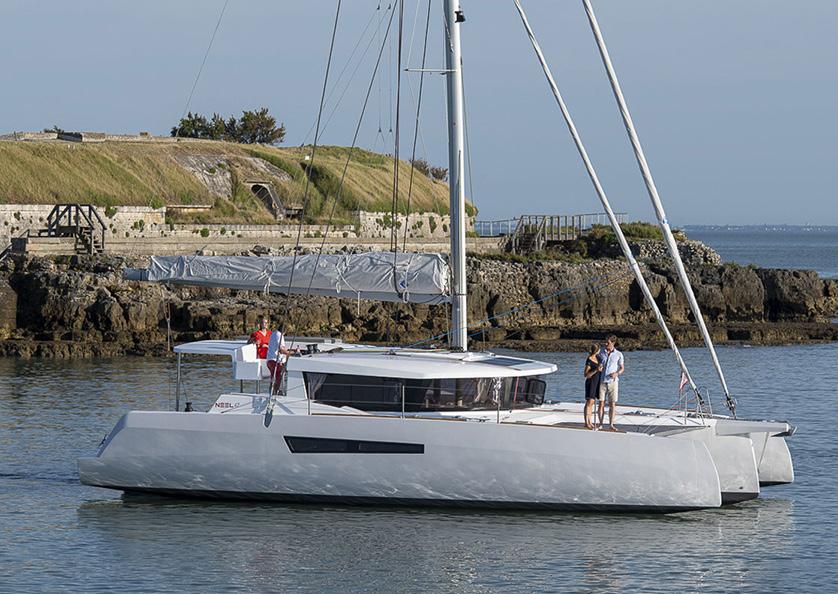
make a fine crewed charter boat or a happy home for a large family.
The 47 was designed by Marc Lombard to be the ideal cruising boat for the Bruneels and their extended family. It has the owner’s cabin next to the saloon and then there are double cabins with their own entrances in the aft ends of the outer hulls or amas. And then, there is a double cabin in the bow of the main hull and single cabins in the bows of the amas. Yikes, berths for 10 people. Yet, this plan works remarkably well. The other notable aspect of the 47 is it’s sailing qualities. It’s a rocket ship.
The brand new 52 was also designed by Marc Lombard and is the builder’s high-performance family cruiser with the sleekest hulls and the raciest profiles and rig. It also has the master cabin adjacent to the saloon and then four double cabins in the port and central hulls. The galley or gourmet kitchen is down on the starboard hull. The 52 would
The 65 is in a class by itself. Sure, a 65-foot cruising boat is large but a 65-foot NEELstyle trimaran is getting into the super yacht category. The saloon is larger than most people’s living rooms at home. The master cabin is a full bedroom, and the galley is a full-size kitchen. Then there are four double cabins and heads down in the hulls plus garages for a large inflatable dinghy and two full-size kayaks. And, there is a full flying bridge with the helm, sail controls and a lounge. With 40 feet of beam, the question might arise of where will you be able to dock this beautiful beast?
Read more.


THE RAPIDO TRIMARAN BRAND GOT A huge boost in the social media world when You Tube vloggers Riley and Elayna of Sailing La Vagabond, with 1.2 million followers, decided to build a Rapido 60 as their next cruising boat.
Rapido was founded in Viet Nam by Australian Paul Koch who had built, with his partners, more than 1,500 catamarans, most of which had folding amas. Koch tasked the noted design team Gino Morelli and Pete Melvin to come up with designs that would be built to be extremely light and extremely fast. And, they’d be all carbon and would have high tech dagger boards. In other words, space-ship level cruising tris.
They now have four models from 40 to
60 feet that they build on a semi-custom basis for individual customers.
The 40 takes all of the special Rapido qualities and boils them down into the essence of what a high-tech performance cruising tri can be all about. This is a boat that can sail at 20 knots, first of all. Then, it is a boat that has two double sleeping cabins and a saloon with a galley and dinette for four adults. The amas can be folded quite easily up against the main hull for trailering or slipping into a marina berth.
The 50 is about the perfect size for a couple who want to live aboard, cruise far and wide and sail all the time instead of motoring from anchorage to anchorage. The cockpit and saloon are almost one

space, while the helm and sail controls are aft where you have good visibility and ready access to sheets and sail control lines. The 50 has double cabins fore and aft plus bench settees that can be single berths. Like the 40, the 50’s amas fold against the hull when berthing or hauling the boat.
The 53 XS was conceived for owners who need three double cabins and want to expand the available living space. By extending the 50’s hull three feet and adding flare to the topsides, Rapido has added a lot of extra space, hence the XS in its name. With this extra space, a double cabin was added adjacent to the saloon and a pilot berth was added outboard of the dinette. For a lot of owners, this larger and more commodious accommodation plan will make sense.
The 60 takes everything Paul Koch dreamed of for his company to the ultimate level. The all-carbon tri will sail at the wind speed in most normal conditions. And, if you look at the design’s polars that predict performance in different wind speeds, you’ll note that 25 knots of boat speed appears regularly. The 60 also is spacious, has a big well protected cockpit, full home-style galley and dinette for six crew and large double cabins fore and aft. This is a boat for a couple with big sailing adventures in their future.
Read here.


THE DUTCH BOAT BUILDER WAARSHIP HAS more than 4,000 boats out on the water sailing around Europe. Most of their boats are built of marine plywood or cold molded of various light woods. They are known for their light, fast designs, both racing and cruising.
But the company developed a high-tech composites subdivision that is building both trimarans and catamarans under the brand High Performance.
The two trimarans, the TR 36 and TR 42,
are Grainger designs and have been engineered to be as light and as fast as possible in boats with normal cruising accommodation, albeit spartan ones at that.
Using the latest cored, infusion techniques, the hulls, decks, bulkheads and stringers are as light as they can be within safe engineering tolerances. Both boats have kick-up centerboards and rudders.
The square-top mainsail rigs, with selftacking jibs and bow sprits for code zeros,
have a huge amount of horse power. With the broad beams and large amas, the boats are incredibly stable and transform wind pressure efficiently into acceleration and forward motion. 15 to 20 knots of boat speed is entire possible.
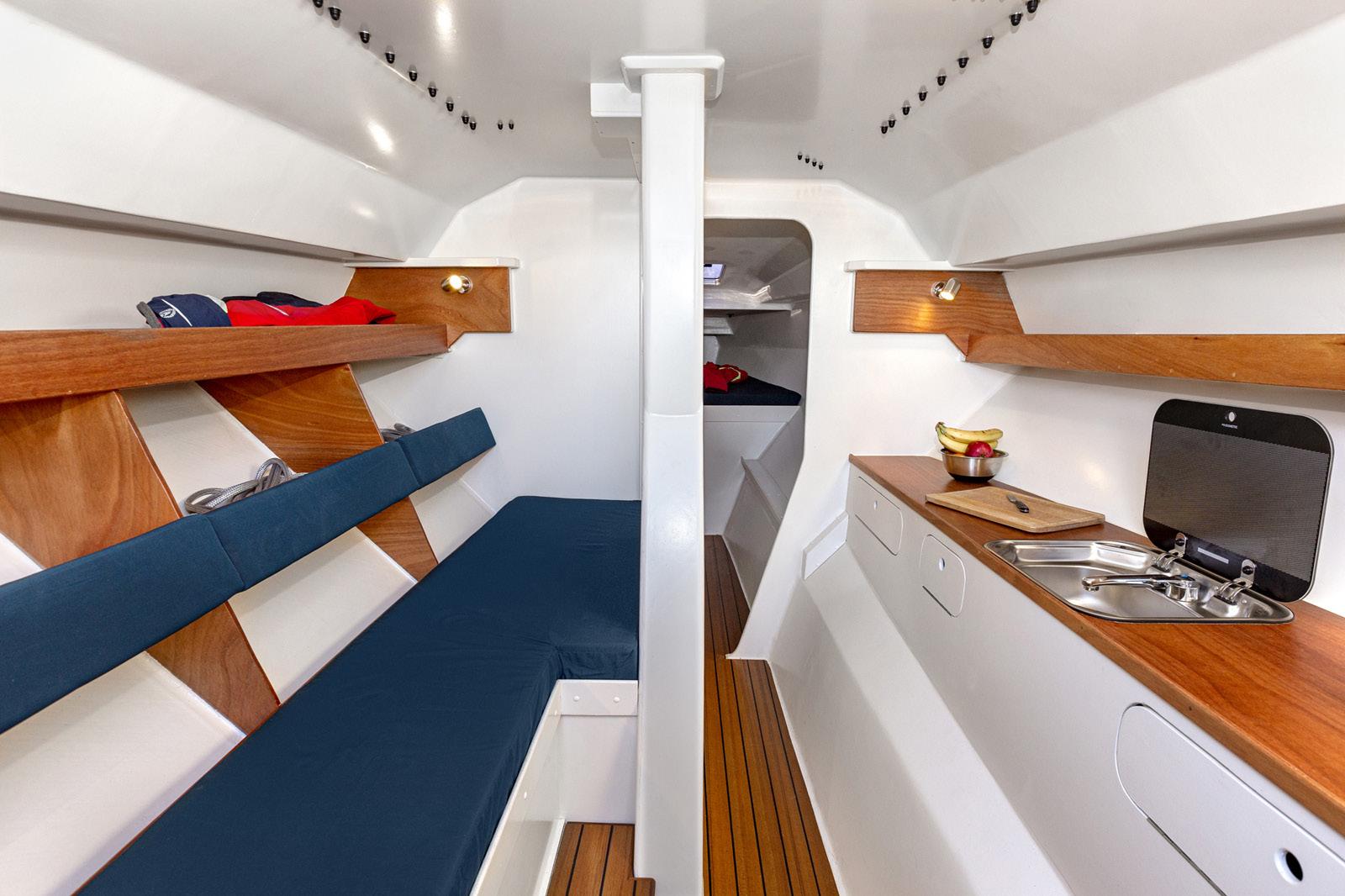
The interior of the 36 has bunks for four, an enclosed head, a small galley and a bench settee. This is old style cruising which was more like camping.
The 42 is more commodious and has berths for six and a proper dinette, as well an enclosed head and full galley. Both boats have small, inboard diesel engines.
Waarship trimarans are built to order but if you are looking for a high performance, ultra-light trimaran for fun sailing, fast cruising and even passagemaking (in the 42), give these unique boats and this builder a second look.
Read more.
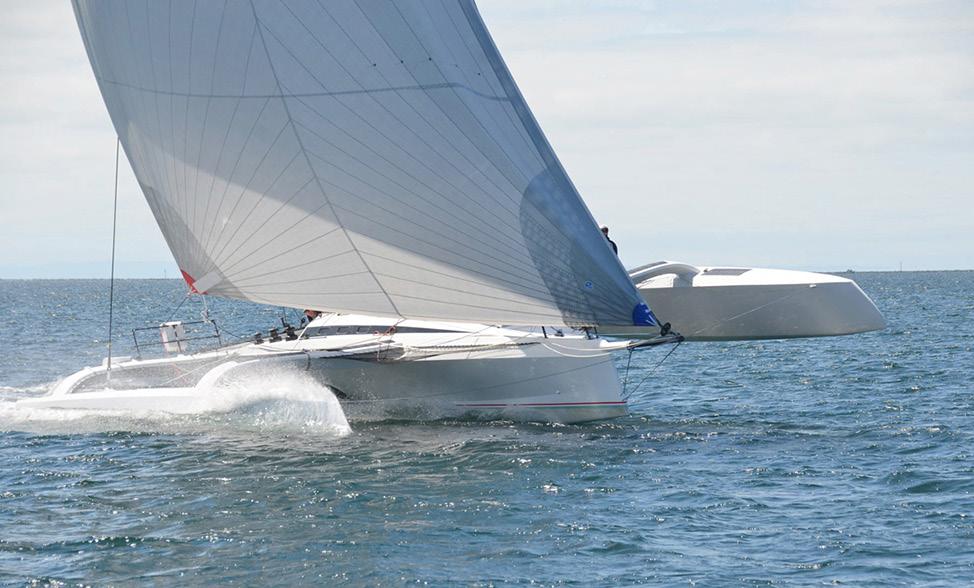
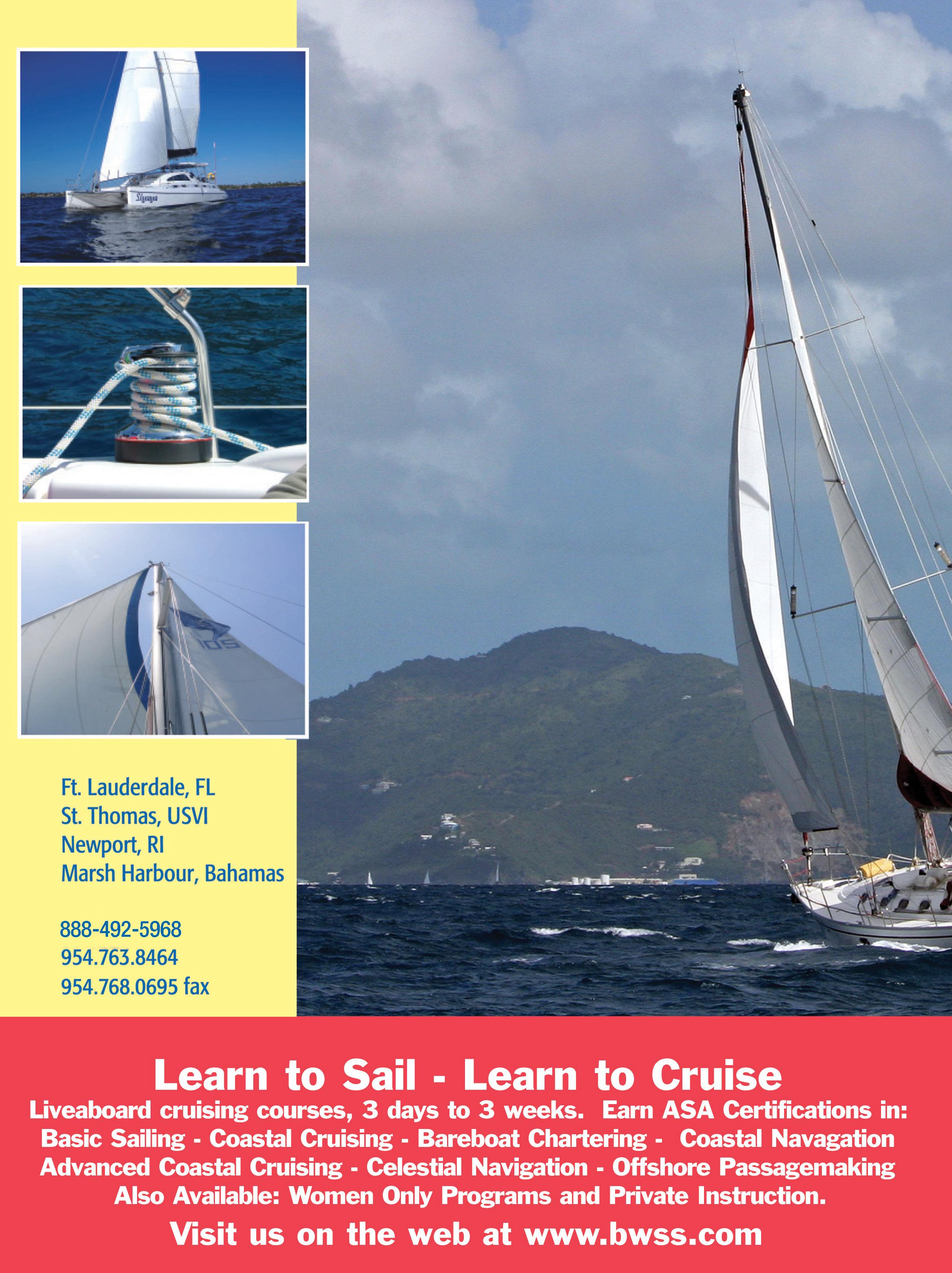

Whatever

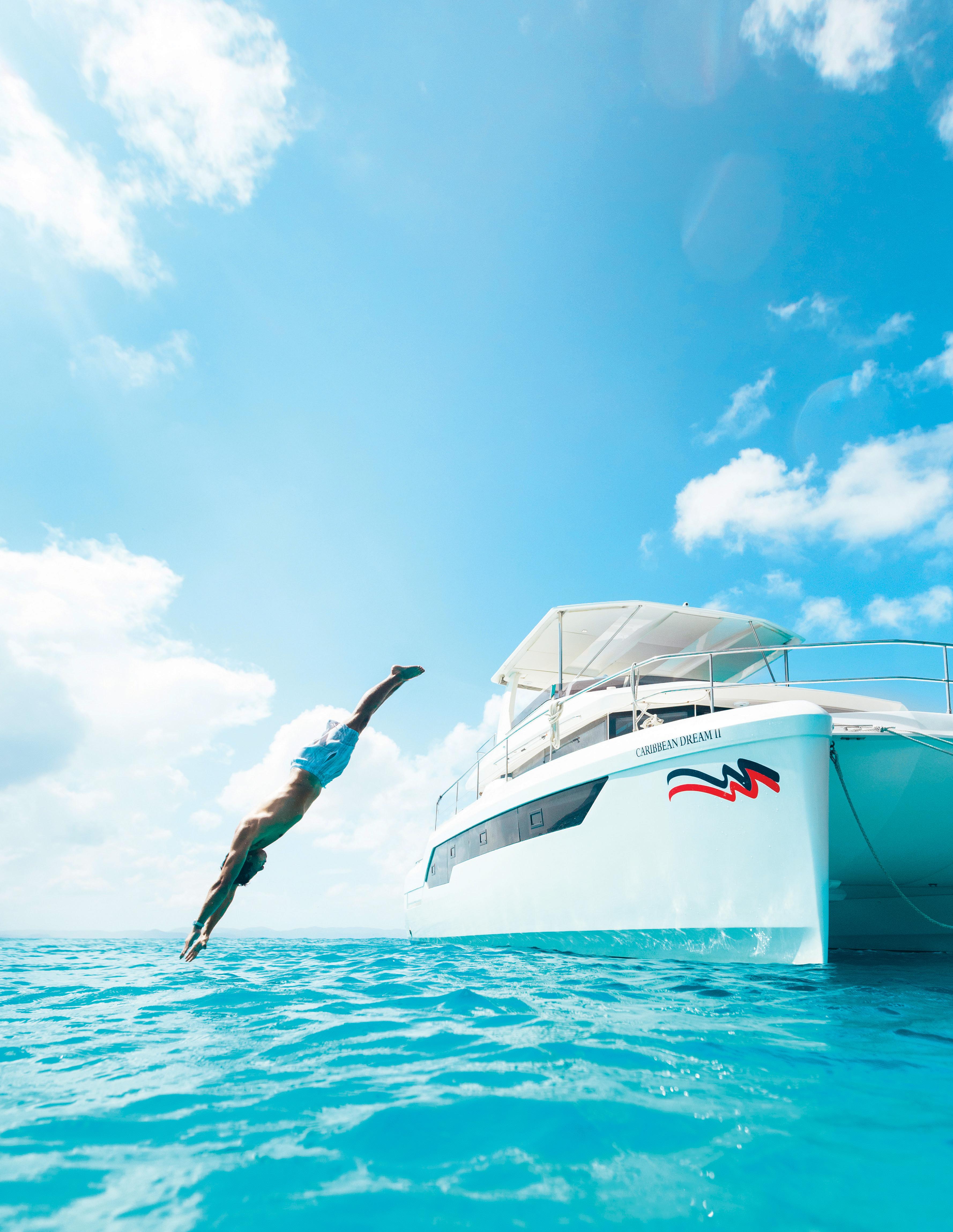




For 50 years, Sunsail has set the standard for sailing vacations in the world’s greatest yachting destinations. With a global team of passionate, experienced sailors, we are proud to share this one-of-a-kind vacation experience with the world - from newbies to old salts, and everyone in between. Join us as we celebrate our golden anniversary, and help us usher in the next 50 years of exploration, adventure, thrilling sailing and unlimited fun. It wouldn’t be the same without you!


“...the best charter experience I’ve had in 20 years of bareboating and flotilla holidays.”
“The Boat and staff were exceptional... doing whatever they could to make our sail perfect. And it WAS!”
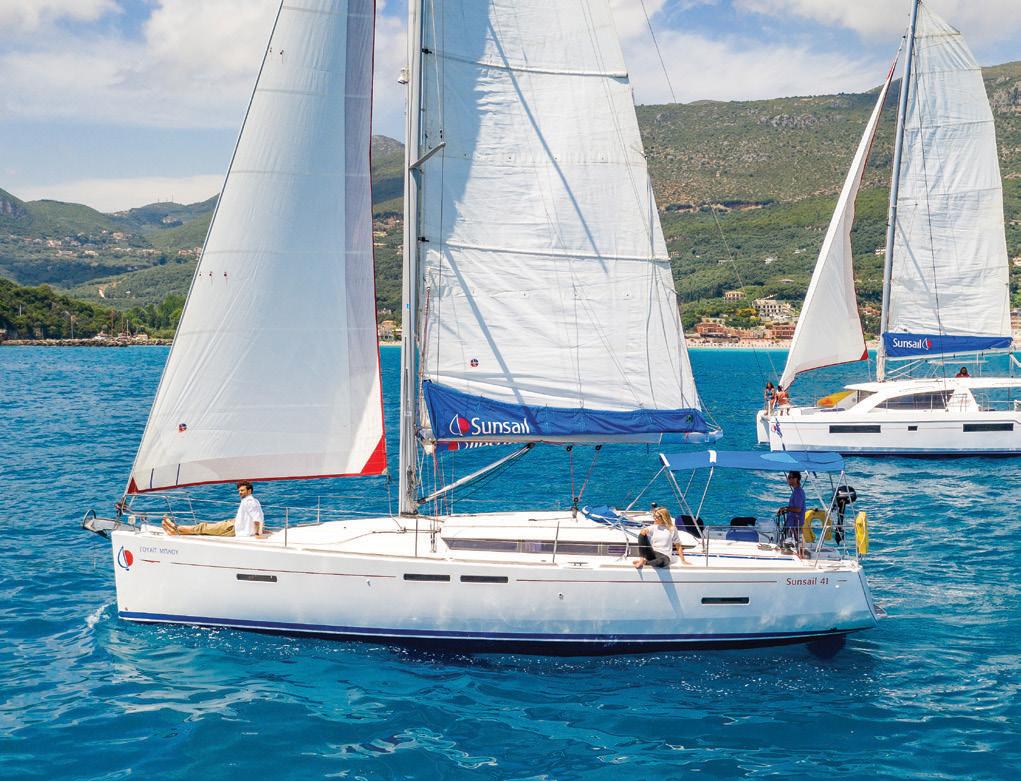


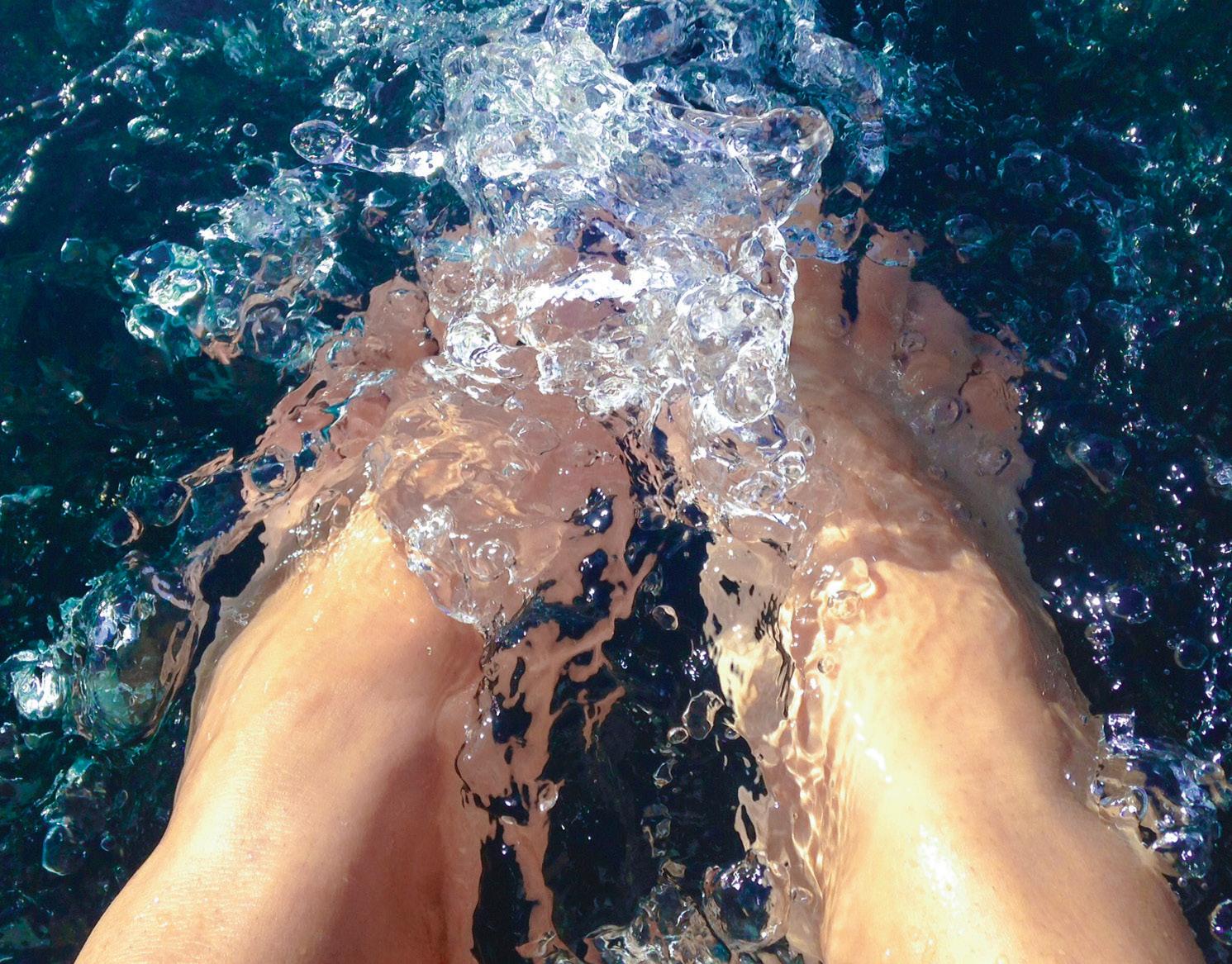






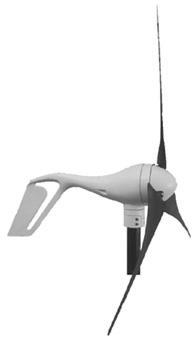


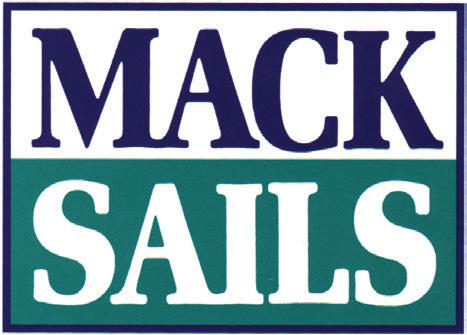
SAILMAKING EXCELLENCE

Two Can Sail

Stuart • FLORIDA • Ft. Lauderdale (772)283-2306 • FAX 283-2433 1-800-428-1384 www.macksails.com EASYSTOW FENDERS®





Want to learn to cruise together as a Couple? Captains Jeff and Jean can help you both become confident as individuals and as a team. Conducting prepurchase surveys, voyage training on your boat. Eastern US, Gulf Coast and Caribbean. www.TwoCanSail.com BOAT SELECTION CONSULTATION SERVICE

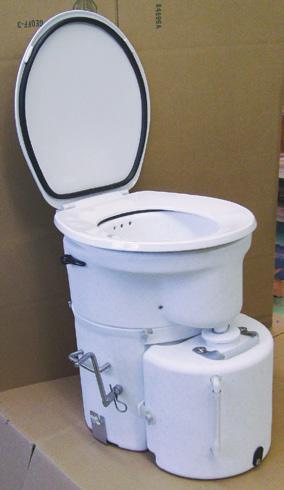

Stop filling up your valuable storage space with air. Easystow Fenders store in as little as 1/12th their inflated size. 5 foot models can replace hard to use fender board arrangements. Practical Sailor rated heavy duty models“best choice”.

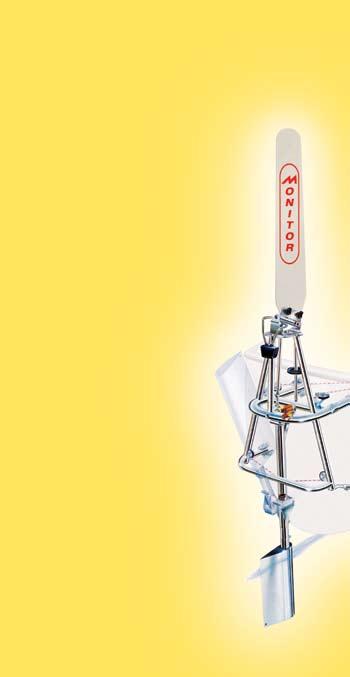
Looking for the right boat for offshore voyaging? For a flat fee I will use my extensive experience to help you evaluate, locate and purchase the best possible boat for your investment. John Neal www.mahina.com/consult

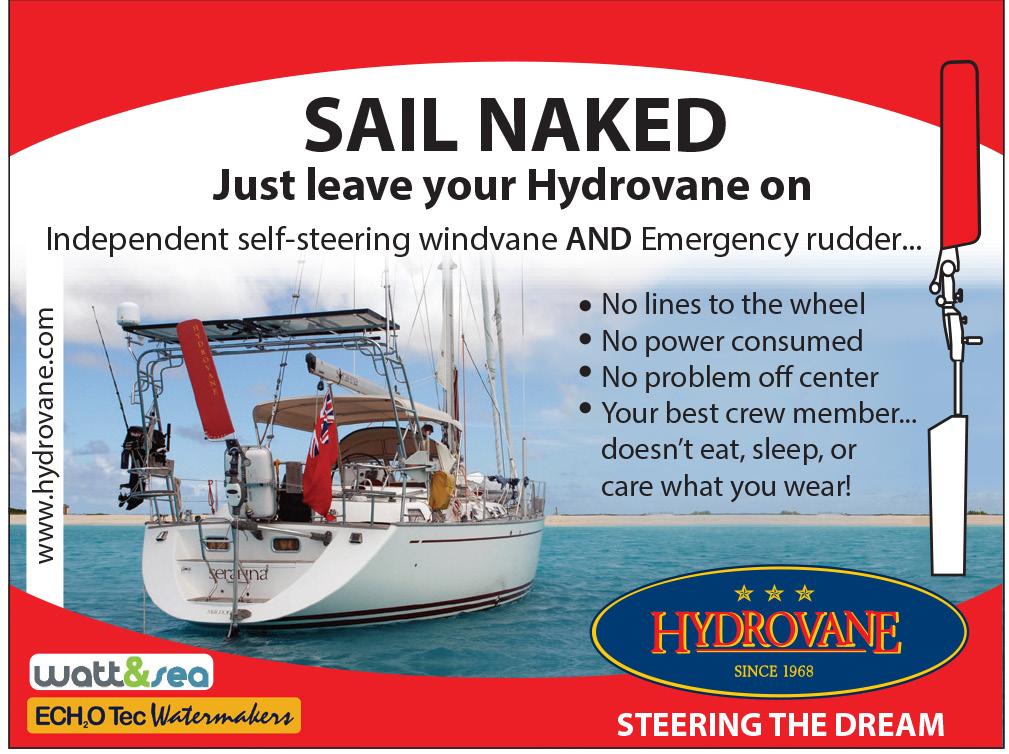
Standing and running rigging, life lines, winches, furlers, line and all types of sailing hardware. We are a rigging shop specializing in discount mail order. Problem solving is one of our specialties. Since 1984. Rigging Only www.riggingandhardware.com e-mail: sail@riggingonly.com or call 508-992-0434
Explore legendary islands including Galapagos, Pitcairn, Tahiti, Bora Bora, Samoa, Tonga and more! Trainee and passengers berths.
Casting off October 2012
Barque PICTON CASTLE (902) 634-9984
www.picton-castle.com